Menu
Hans Urs von Balthasar
Priest, theologian, retreat-master, publisher, editor, translator, co-founder of a secular institute–Hans Urs von Balthasar bore exemplary witness to Christ, the Alpha and Omega who reveals God and unveils the destiny of creation.
Childhood and Education
Hans Urs von Balthasar was born on August 12, 1905 in Lucerne, Switzerland. The Balthasars were a patrician family with a long record of distinguished service to the city and canton of Lucerne. Hans Urs’ father, Oskar, ran the cantonal department of public works. His mother, Gabriele née Pietzker-Apor, was descended from Hungarian barons.
The future theologian began his secondary education as a boarder at the Abbey School of Engelberg, Switzerland, but later transferred to the Jesuit school located just over the Austrian border in Feldkirch. After finishing high school in 1923, he studied literature and philosophy in Vienna, Berlin, and Zurich. It was there that, in 1928, he defended his doctoral dissertation on the “History of the Eschatological Problem in Modern German Literature,” which formed the basis of his first trilogy, the Apocalypse of the German Soul (1937-1939). Engagement with the history of thought in the light of Revelation would henceforth remain an important feature of his work.
Even as a child, Balthasar was devoted to music. A talented pianist trained by a student of Clara Schumann, he originally aspired to become a symphony director. His first published work–written while he was still in college–was also about music: “On the Development of the Musical Idea. Towards a Synthesis of Music” (1925).
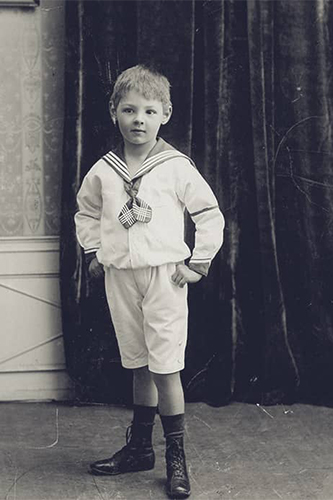
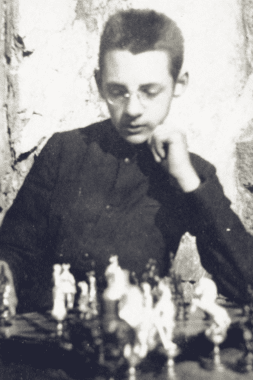

- Hans Urs von Balthasar as a child
- Balthasar as a high school student in Feldkirch, Austria
- Balthasar (center) as a college student with his parents and his brother Dieter and sister Renée
Encounter with Ignatius and Entrance into the Society of Jesus
During an Ignatian retreat in the Black Forest in 1927, Balthasar received a “sudden, unexpected vocation” to follow Christ in the consecrated life. The answer to this call led him to join the Jesuits two years later.
As a Jesuit scholastic, Balthasar studied philosophy in Pullach (near Munich) and theology in Lyon-Fourvière (France). During this time, he was greatly influenced by two fellow Jesuits: Erich Przywara and Henri de Lubac. The former helped him discover the principle of analogy at the heart of the Catholic faith, while the latter introduced him to the universal spirit of patristic theology.
An important fruit of Balthasar’s time in Lyon was a series of monographs on Origen, Gregory of Nyssa, and Maximus the Confessor, to which he would add numerous translations and anthologies of the Church Fathers, especially Augustine. It was during his Lyon years that Balthasar also became familiar with Péguy, Bernanos, and Claudel—writers whom he would help introduce to the German-speaking world through his translations, anthologies, and studies.
In 1936, Balthasar was ordained to the priesthood by Cardinal Faulhaber, Munich’s courageously anti-Nazi Archbishop. The card commemorating his first mass depicted John leaning on the Lord’s breast at the Last Supper. The motto he chose to accompany the image, “benedixit, fregit, deditque” (he blessed, broke, and gave), expressed his ideal as a Jesuit and a priest: definitive self-gift to the Lord and readiness to be broken and distributed eucharistically with the Master.
Upon completing his studies, Balthasar was sent by his superiors to work as an editor of Stimmen der Zeit, a Jesuit journal based in Munich. His tenure with Stimmen der Zeit was cut short, however, by his expulsion from Nazi Germany in 1939. The following year, he turned down the offer of a professorship at Rome’s prestigious Gregorian University, preferring to minister to students and young professionals as a chaplain at the University of Basle.
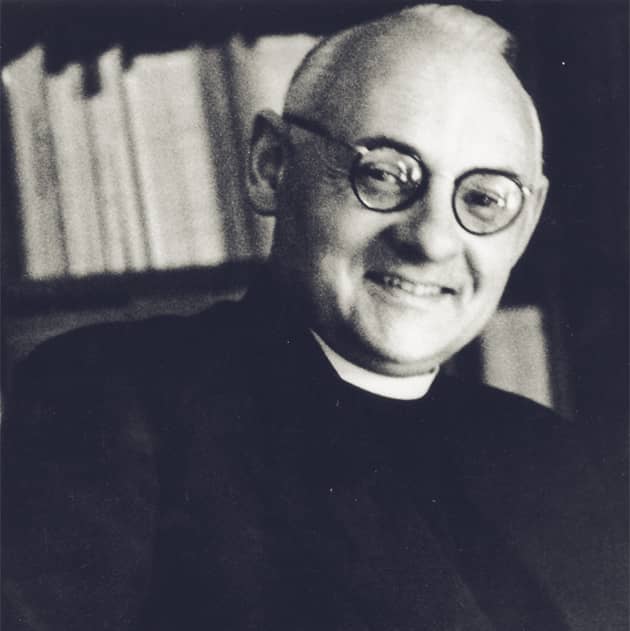
- Balthasar as a student chaplain at the University of Basle
- Balthasar with his student group during a summer theology course in Switzerland (1948)
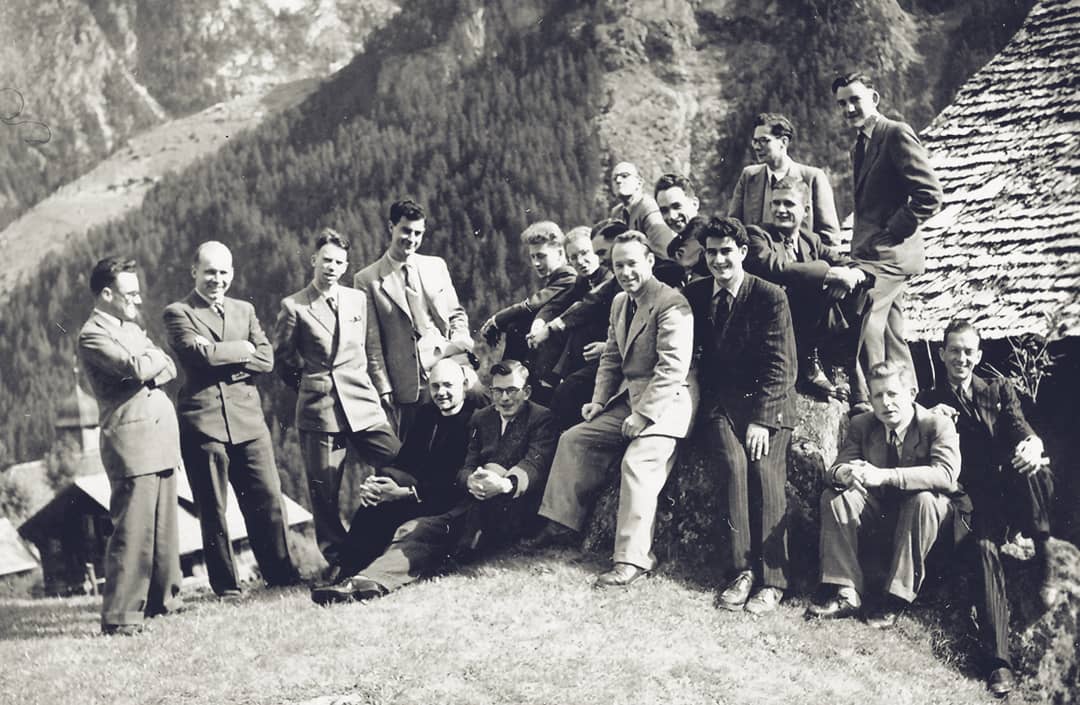
- Balthasar as a student chaplain at the University of Basle
- Balthasar with his student group during a summer theology course in Switzerland (1948)
The Encounter with Adrienne von Speyr and the Beginning of their Collaboration
Shortly after taking up his post in Basle, Balthasar met Dr. Adrienne Kaegi-von Speyr, the wife of a well-known professor of history at the city’s university. A Protestant with a lively interest in Catholicism, Adrienne had been looking for an opportunity to speak to him about her religious journey. Balthasar, who would eventually become her confessor, received her into the Church via conditional baptism on November 1st, 1940 and gave her instruction in the fundamentals of the Catholic faith.
Balthasar’s encounter with von Speyr would mark a turning-point in his life. Immediately after her conversion, she began to receive a cascade of mystical graces whose correct interpretation–in and for the Church–required the help of a confessor. Her charism included a special aptitude for commenting on Scripture in a way that unlocked its riches for contemplative prayer. This, too, called for Balthasar’s help. Over a period of many years, Adrienne would dictate about 70 volumes of material, all of which Balthasar took down in shorthand and prepared for publication. The Johannes Verlag, or Saint John Press, which he founded in 1947, served to publish these works of Adrienne–as well as to make known other classic and contemporary voices of the living Catholic tradition.
The common work entrusted to Balthasar and von Speyr reached a culmination in 1945 with the foundation of the Community of Saint John (Johannesgemeinschaft), a secular institute devoted to living the evangelical counsels at the heart of the world. The Community’s patron is the beloved disciple, though Ignatius of Loyola also plays an important, if discreet, role in the Community. These two figures, for Balthasar and Adrienne, are united in their appreciation of the link between love and obedience that, archetypally embodied by Christ, is reflected in those called to follow him.
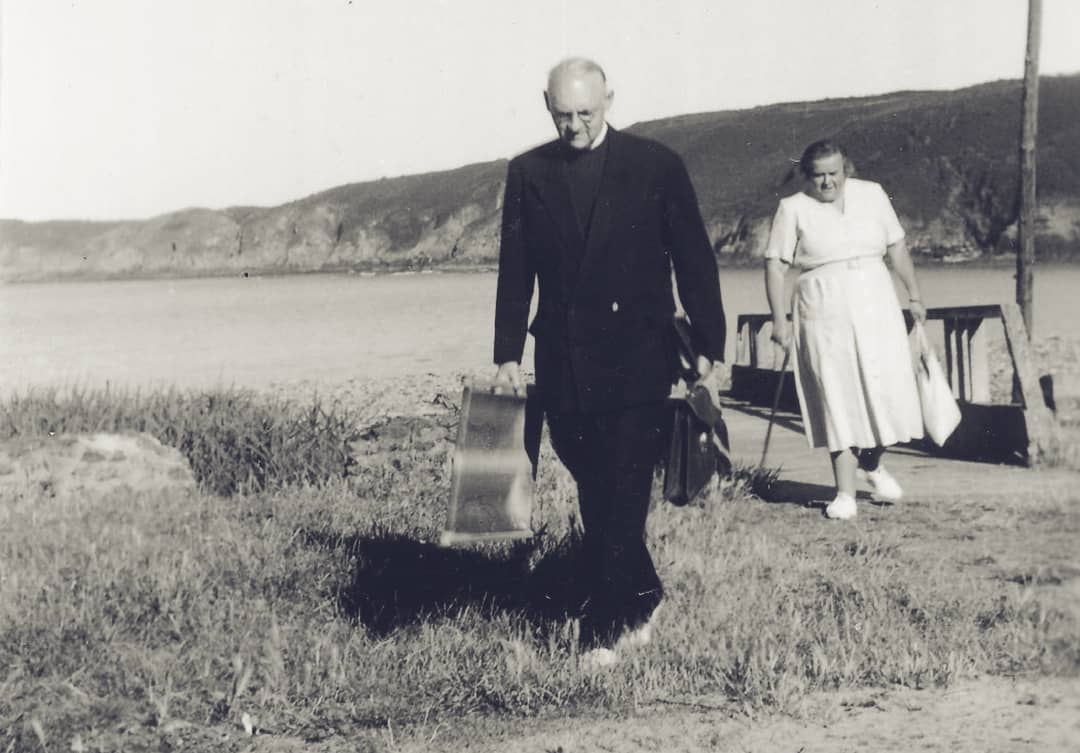
Hans Urs von Balthasar and Adrienne von Speyr in Saint-Quay, Brittany, during a vacation with the Community of Saint John (1954)
Balthasar’s collaboration with Adrienne (under the sign of Saint John, whom the Eastern Church venerates as “the theologian” par excellence) was a decisive influence on his own theological work. Above all, it confirmed his commitment to a “kneeling theology,” conjoined with living faith, that took its bearings from the witness of the saints and mystics (“Theology and Sanctity,” the title of one of his essays from the 1940’s, also summed up his own theological program.) In all this, as Balthasar himself would later observe, the center of his work remained “the Community of Saint John. Second comes the Press, which is dedicated to the vast corpus of Adrienne von Speyr’s writings along with the works of numerous other authors. My own publications I would put third and last” (Hans Urs von Balthasar, Zu Seinem Werk).
This period of intense activity was also a time of soul-searching for Balthasar. After a prolonged discernment culminating in an Ignatian retreat, he took the painful decision–with the consent of his superiors–to leave his “supremely beloved [Jesuit] homeland” before final vows. Upon finalizing this step, he renewed his commitment to the evangelical counsels in the abbey church of Maria Laach. The rest of his priestly life would now be devoted to the Ignatian (and Johannine) mission to which God had called him.
Ecclesial Service in the Footsteps of John and Ignatius
Following a brief residence in Zurich, Balthasar eventually settled in Basle, where he devoted himself to guiding the Community of Saint John, publishing the works of Adrienne, and directing the Johannes Verlag (for which he edited 13 series and produced numerous translations, anthologies, and prefaces). Fully engaged as a writer and speaker, he was also much in demand as a spiritual director and retreat master, especially for young people and students.
1961 saw the publication of the opening volume of what would become his magnum opus, the Trilogy, which presents divine Revelation in light of the beautiful, the good, and true. The first part of the Trilogy, The Glory of the Lord (1961-1969), revolves around the glorious manifestation of divine beauty, the second part, the Theo-drama (1973-1983), focuses on the dramatic confrontation between divine and human freedom, while the third and final part, the Theo-logic (1985-1987), is dedicated to the analogy between the truth of God and the truth of the world. All three parts display Balthasar’s characteristic mix of theological originality and creative mastery of Western thought.


- Balthasar with John Paul II during an international symposium on the ecclesial mission of Adrienne von Speyr organized at the Pontiff’s behest (1985)
- Balthasar vacationing on the Rigi (Switzerland) with his friend and former teacher, Henri de Lubac
Alongside the Trilogy, Balthasar produced numerous writings dealing with the life of the Church. In Razing the Bastions (1952), he anticipated the authentic program of Vatican II: fearless engagement with modernity that presupposed Catholic identity rather than adulterating it. It was just this adulteration that he firmly opposed in the wake of the Council with works like Who is a Christian? (1965) and Cordula (1966). From beginning to end, Balthasar saw the relation between Church and world through the lens of a theology of lay consecration informed by the understanding of the ecclesial states of life developed in works such as The Christian State of Life (1977). The world’s theological significance, he thought, does not lie in an autonomous kingdom of man, but in the Paschal Mystery of Jesus.
Although Balthasar’s work was already being read with appreciation throughout Europe by the early ‘50’s, recognition of his contribution to the Church began in earnest in the latter half of the decade. In 1969, he was appointed to the International Theological Commission by Paul VI. The Golden Cross of Mount Athos, which he had received in 1965, underscores the ecumenical significance of his work–as does his decades-long engagement with the Protestant theologian Karl Barth, with whom he shared his passion for music, especially Mozart.
By the early ‘70’s, Balthasar had emerged as an important reference-point for the authentic interpretation of the Second Vatican Council. It was to foster the Council’s genuine work of theological ressourcement that, along with Joseph Ratzinger, Henri de Lubac, and others, he launched the international theological journal Communio, which began publication in 1973 and would eventually appear in fourteen different languages.
Balthasar’s international reputation is attested by numerous prizes and honors belonging roughly to the same period: The Central Swiss Prize for Culture (1956), doctorates honoris causa from Edinburgh (1965), Münster (1965), Freiburg (1967), and the Catholic University of America (1980), the Romano Guardini Prize awarded by the Catholic Academy of Bavaria (1980), Zurich’s Gottfried Keller Prize (1975), and the Salzburg Wolfgang Amadeus Mozart Prize (1987).
In 1984, Balthasar was awarded the Paul VI Prize by Pope John Paul II, who knew and appreciated his work. It was the same Pope who, in naming him a cardinal on May 28th, 1988, set the final seal on his Johannine service to the Church sub Petro and cum Petro.
Balthasar died at home in Basle on June 26th, 1988–just three days before his official induction into the College of Cardinals. His funeral was celebrated by then Cardinal Ratzinger in Lucerne’s Hofkirche, where he was also laid to rest (show on map). Balthasar’s last book–the posthumously published Unless You Become Like This Child (1988)–bears witness to the spirit of evangelical childhood that he kept alive to the very end.
“What Balthasar wanted may well be encapsulated in a single phrase of St. Augustine: ‘Our entire task in this life, dear brothers, consists in healing the eyes of the heart so they may be able to see God.’ That is what mattered to him, healing the eyes of the heart so they would be able to see the essential, the reason and goal of the world and of our lives: God, the living God” (Joseph Cardinal Ratzinger, “Homily at the Funeral Liturgy for Hans Urs von Balthasar,” Communio 15 [Winter 1988]).
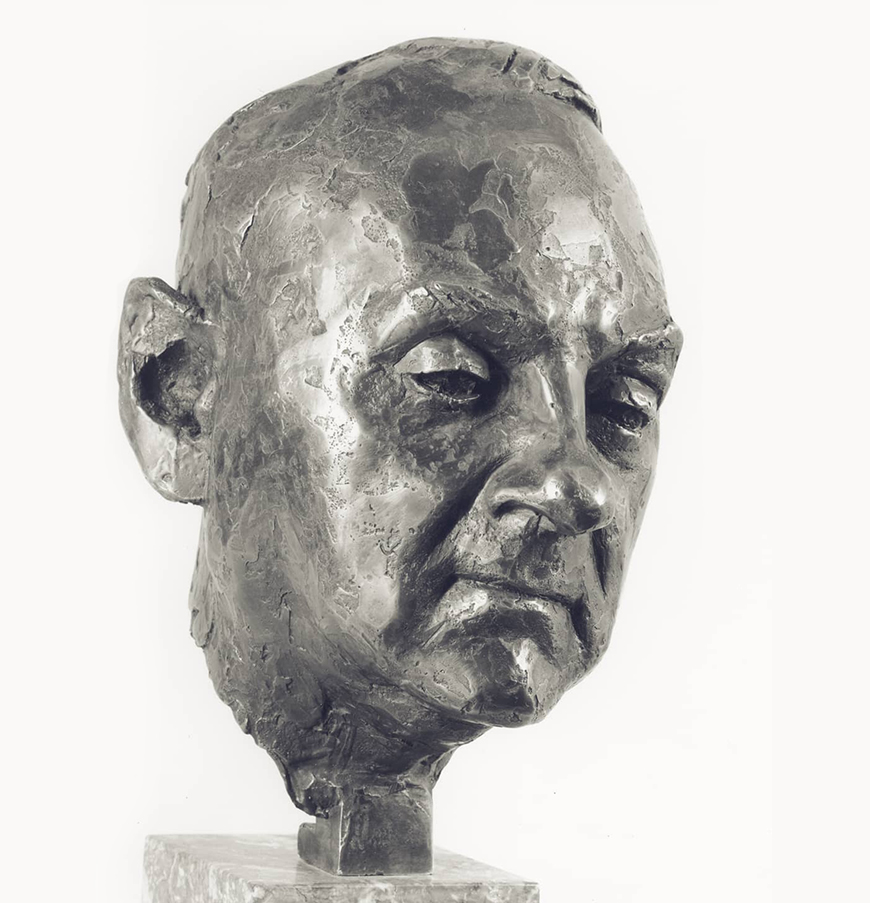
- Bust of Hans Urs von Balthasar by the sculptor Albert Schilling (1965)–© Leonard von Matt / Fotostiftung Schweiz
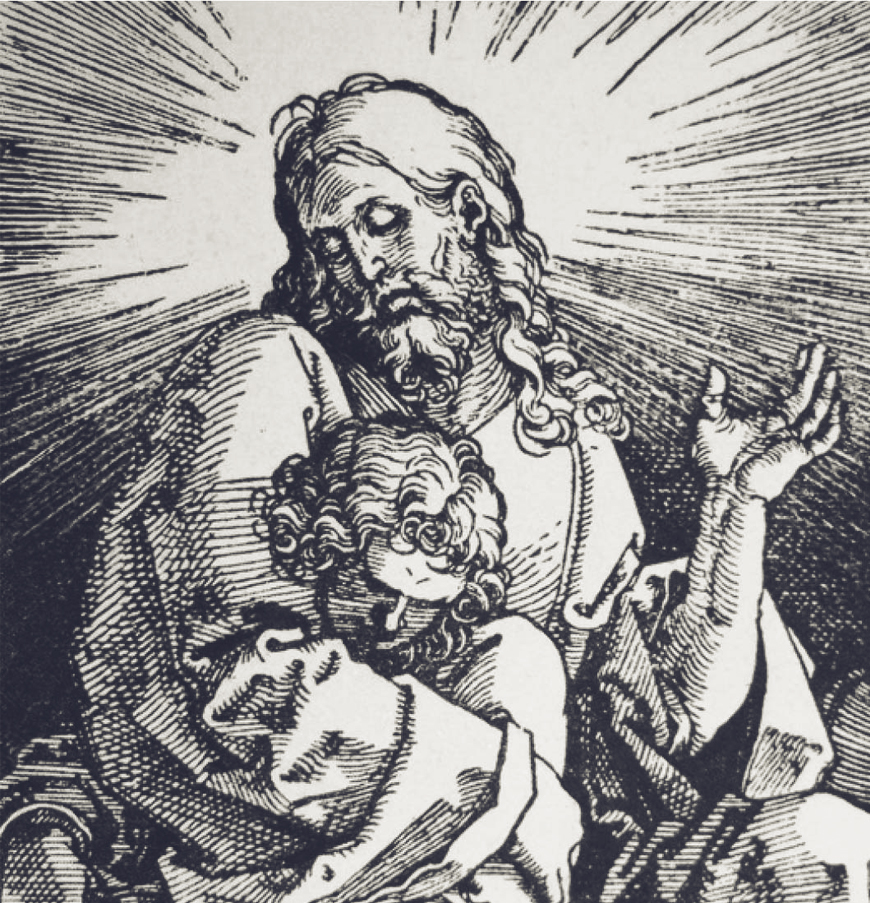
- Detail from Balthasar’s ordination card: Dürer’s image of John reclining on Jesus’ breast at the Last Supper accompanied by the motto “Benedixit, fregit, deditque”
Further Reading
- Balthasar, Hans Urs von, Our Task. A Report and a Plan (San Francisco: Ignatius Press, 1994).
- Balthasar, Hans Urs von–Albus, Michael, “Spirit and Fire. An Interview With Hans Urs von Balthasar,” in Communio. International Catholic Review 32. 3 (2005): 573-593.
- Benedict XVI, Message of His Holiness Benedict XVI for the Centernary of the Birth of Fr. Hans Urs von Balthasar (6 October, 2005). Available on the Vatican website.
- Scola, Angelo, Hans Urs von Balthasar. A Theological Style (Grand Rapids: William B. Eerdmans Publishing Company, 1995).